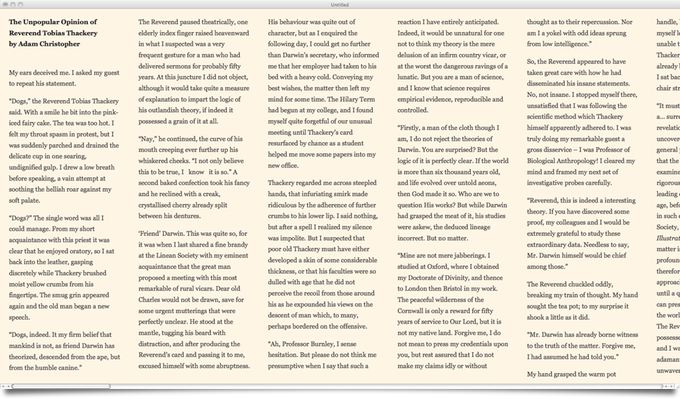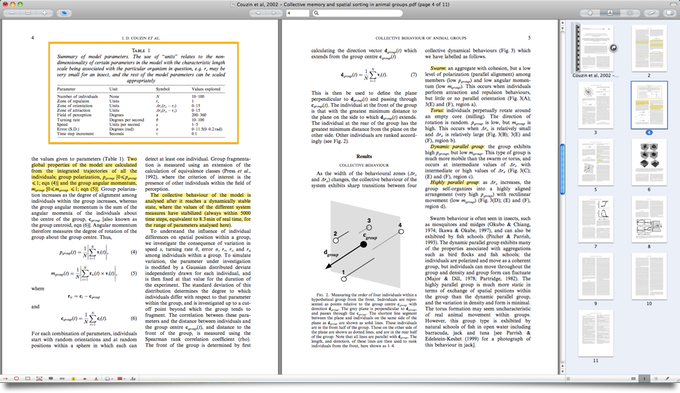NetNewsWire Folders
I use NetNewsWire as my newsreader. I like it, but I wish that it would display a list of posts (or even just unread posts) from subscriptions in a folder when that folder is selected. This is how Google Reader works, and it is a sensible behavior. Perhaps I’d like to read all bike-related news, instead of opening the folder to look at items blog-by-blog.

Is there an option I have overlooked that enables this sort of behavior?
Clarification: NetNewsWire does this with unread posts – all new items from subscriptions within a folder appear together when you select the folder – but I’d like to be able to browse all items, whether or not they’re new.
Posted on Friday, April 16th, 2010. Tags: mac.
A Phenomenal Handheld Electronic Device
There’s been a lot of talk about incredible new portable computing devices recently. Well, the rumors are true – the TI-92 is a great machine. The hardware is solid, the software is sophisticated and extensible (lots of apps; the graphics were ahead of its time), and for all practical purposes the batteries never die.
Posted on Saturday, April 10th, 2010.
My Interpretation of the Litany Against Fear
Dune is a work of fiction, but it presents philosophies I accept as powerful kernels of real-world wisdom. Here is the Bene Gesserit Litany Against Fear, introduced in Herbert’s 1965 classic:
I must not fear.
Fear is the mind-killer.
Fear is the little-death that brings total obliteration.
I will face my fear.
I will permit it to pass over me and through me.
And when it has gone past I will turn the inner eye to see its path.
Where the fear has gone there will be nothing.
Only I will remain.
Confrontation and acknowledgement transforms fear into an understanding of risk. To face fear – or to embrace joy, for that matter – is not to be deluded by denial or delight, but to be human: to recognize emotion as an indicator of important experience.
As a cognitive tool, the Litany guides us to observe and identify sources of uncertainty. Observation changes challenges by changing how we see them; the paralyzing fog is dispelled by our gaze to reveal specific obstacles that can be attended to in turn.
I think this is especially useful as an approach to the anxiety that can sometimes inhibit opportunity or ambition. What will you tackle next?
Posted on Friday, April 9th, 2010. Tags: books, quotes, reviews.
Yank My Chain
My bike chain collects a lot of grit and gunk, especially when I ride in the rain. Grit makes the drivetrain operate less smoothly – I hate the crunchy, fragile feel of a chain full of road cinders. Hauling the bike in to the bathtub may be fun, or funny, but it is cumbersome. Of course, the chain is most easily cleaned by itself, but that still makes a greasy mess. So, I finally went the gadget geek route and bought a Nashbar chain cleaner.
Not that I mind the occasional greasy mess.
Haven’t used it yet, but I’ll let you know how it goes!
Posted on Wednesday, April 7th, 2010. Tags: bike.
Hugo Nominations
 The nominees for the 2010 Hugo awards were announced today at Eastercon. I mention this for three reasons:
The nominees for the 2010 Hugo awards were announced today at Eastercon. I mention this for three reasons:
- StarShipSofa received a nomination for Best Fanzine. This is the first time a podcast has been on the ballot for a Hugo award. I began listening to StarShipSofa late last year and quickly became a fan; many of the short stories I’ve mentioned here were heard on the ‘Sofa. In February, I voiced my support for the good ship’s nomination campaign in A Hugo for the StarShipSofa, so I am quite pleased to see this recognition for everyone involved in its production – especially editor Tony C. Smith.
- StarShipSofa qualifies as a “fanzine”, but there’s nothing amateurish or obscure about it or other popular SF podcasts. In the few months since I started listening to these shows, I’ve heard a number of the stories that were nominated and learned of a few more. (I suspect I may hear even more as I work my way back through the archives.) For example, I heard and reviewed The Gambler by Paolo Bacigalupi via ‘Sofa 121; on the strength of that story and other online recommendations, I bought, read, and enjoyed Paolo’s debut novel The Windup Girl, which is among the candidates for Best Novel.
- I take the remainder of the nominees – those I haven’t read, heard, or heard of – as worthy additions to my reading list!
A few notes on other notable nominees:
- I haven’t read Peter Watts’ Best Novellete-nominated story The Island, but I did read and review his novel Blindsight. I’m glad for that bit of good news amidst other dismaying developments in Peter’s life.
- Although I haven’t posted any reviews yet, I listen to the Clarkesworld magazine podcast and have notes on a few stories, including Best Short Story nominee Non-Zero Probabilities by N. K. Jemisin. Clarkesworld itself is a nominee for Best Semiprozine. Again, I emphasize that podcasts provide great exposure for some of the top content in the genre.
- Somewhat surprisingly, I’ve seen every film nominated for Best Dramatic Presentation, Long Form: Avatar, District 9, Moon, Star Trek, and Up. I’m not sure which I would vote for.
Posted on Sunday, April 4th, 2010. Tags: books, clarkesworld, reviews, starshipsofa.
Words About Words I Done Heard
Regulars by Frank Oreto (via Pseudopod 158)
Business is good at Jimmy’s bar, Drakes –
a regular crowd’s all that it takes.
They pay cash to devour
loners caught after hours –
it’s money, but still Jimmy’s heart breaks.
You have to make sacrifices if you want to succeed in this business.
 Woman Called Witch by Doug McIntire (via Dunesteef 145)
Woman Called Witch by Doug McIntire (via Dunesteef 145)
What shape does Fate take
to end men in her embrace?
All will see her face.
The narrator witnesses an old woman intervene in a bank robbery. He is a petrified hostage; she is grandmotherly, inexplicably calm, and in one brief but decisive moment, terrifyingly fearsome. She is called Witch, and one day you may know her, too.
What Fluffy Knew by Kristine Kathryn Rusch (via Drabblecast 153)
Fluffy, housecat queen,
spies wee earwig invaders
and begins the hunt.
Ignore your vet – the tabloids are right. If your pets suddenly become vicious, it’s due to mind control parasites deployed by little flying saucers. Fortunately, Fluffy the domestic diva was present to observe the miniature aliens plant their bugs in her tomcat housemates’ ears. As anyone who’s ever played with a cat knows, there are certain threats our feline friends are well equipped to confront – so the outlook is grim for invaders who make such fun-to-chase morsels.
Film-Makers of Mars by Geoff Ryman (via StarShipSofa Aural Delights 57)
Dusty reels; real FX.
John Carter of Mars conquers
on film and in flesh.
Footage from an early silent movie adaptation of Edgar Rice Burroughs’ Barsoom series surfaces at a film festival. In some ways it is predictably dated, but the apparent age of the actors and the astounding quality of the special effects – from a grisly slaying to the fluid motion of the indigenous Tharks – raise doubts about the film’s vintage. As the protagonist investigates, however, he finds evidence that the footage is entirely authentic.
Bridesicle by Will McIntosh (via StarShipSofa Aural Delights 124)
The lost are not gone, just kept on ice:
brides are in stock, revived for a price.
Each date’s a taste of life
for each unwed dead wife –
and also, one, whose love lies alike.
As if cryogenic preservation wasn’t creepy enough, imagine adding a dose of mail order marriage to the mix. That’s the world of Bridesicle, where the dead may find themselves arrayed like so many flavors in an ice cream freezer to be sampled by wealthy suitors. It’s hard enough to repeatedly suffer a few minutes of rusty reanimation just to be rejected and returned to death, but Mylee, the main character, must reconcile this desperation with her disinterest in the men who could fund her resuscitation.
A Light in Troy by Sarah Monette (via PodCastle 94)
“There is still a child!”
She is chattel, but she guides,
and he holds her hand.
An aged master, more scholar than menace, beholds with mercy the hope of a woman whose people his crushed. Hope springs eternal.
The Identifier by Mark Patrick Morehead (via Pseudopod 184)
We who remain sort
history’s debris in bins,
and yet still we sing.
The human spirit prevails, even as our pitiable remainder is made to sift through the rubble of civilization. A tabletop IED, a bottle of wine, and a scratched Tchaikovsky CD make for one last wonderful evening in hell.
Posted on Thursday, March 25th, 2010. Tags: drabblecast, dunesteef, haiku, limerick, podcastle, pseudopod, reviews, starshipsofa.
Processing Syntax Coloring in TextWrangler
Processing is based on Java. TextWrangler supports syntax highlighting for Java code, but it doesn’t automatically recognize that Processing uses Java syntax. So, head over to the Languages pane of TextWrangler’s preferences and click Add next to the Suffix Mappings list. Enter .pde as the Extension and select Java as the language that should be associated with .pde files.

Now if you open a Processing source code file in TextWrangler, it will be displayed with basic syntax highlighting.
Posted on Thursday, March 18th, 2010. Tags: code, java, mac, processing, textwrangler.
Reading on the Big Screen
Big displays are worthwhile because they improve the ratio of visible content to “computer stuff”.
Here is a story from Issue 114 of Hub Magazine viewed in Tofu, a little app that displays text in a side-scrolling columnar format suitable for comfortable reading. The story is The Unpopular Opinion of Reverend Tobias Thackery, by Adam Christopher. Yes, we are all dog-men.

Two pages of a document can be displayed side-by-side at life size (in other words, the image of the typical page is eleven inches tall, just as it would be if printed). This is especially useful when reading documents whose layout would require scrolling back and forth to follow the flow of text on a smaller screen.

What am I reading? The paper which introduced the collective animal behavior model presented by Iain Couzin at a recent EvoS seminar:
Couzin, I. D., Krause, J., James, R., Ruxton, G. D., & Franks, N. R. (2002). Collective Memory and Spatial Sorting in Animal Groups. Journal of Theoretical Biology, 218(1), 1-11. (PDF)
I’d like to write my own implementation of the model (or some representative subset) in Processing. I spawn a lot of eventually-neglected side projects, of course, but right now this subject has my attention.
Posted on Sunday, March 14th, 2010. Tags: mac.
Add Curved Drop Shadow plugin for Acorn
This is a variation on the Curved Drop Shadow without Border plugin for Acorn I posted a few days ago (which is itself a derivative of the original Create New Image with Curved Drop Shadow plugin). It adds the drop shadow to the current image instead of spawning a new document. The drop shadow is added to the active layer.
Download AddCurvedDropShadow.py (2.3 KB) and install it in ~/Application Support/Acorn/Plug-Ins.
Posted on Sunday, March 14th, 2010. Tags: acorn, mac, python.
No Book is an Island
Today I started reading The Windup Girl by Paolo Bacigalupi. So far, it’s as excellent as the testimonials claim. Having recently read Sundiver by David Brin, I noticed what seems to be a subtle nod to that story in one of the opening scenes of Windup Girl.
From the first chapter:
Cycles and rickshaws and megodont wagons flow past them, parting like a river around boulders. The cauliflower growths of fa’ gan fringe scar the beggars’ noses and mouths.
From the first chapter of Sundiver:
Bright points of static filled the space above the blankets and in front of the screen, and then Fagin stood, en-replica, a few inches away.
The E.T. did look somewhat like a giant sprout of broccoli.
An ailment called fa’ gan that looks like cauliflower and an alien named Fagin that looks like broccoli, both introduced in the first chapter of each author’s debut novel? It could be a coincidence – perhaps “fa’ gan” has a meaningful real-world etymology – but I like to think it’s an “easter egg” for the well-read geek. Now I’m going to be on the lookout for other genre references!
Upon further reflection, it occurs to me that there is an additional commonality which might suggest a more specific reason for this reference: both books deal with evolutionary themes.
As part of the Uplift series, Sundiver examines a universe in which humanity’s haphazard evolution is an exception to the norm of guided intervention. Windup Girl is set in a world populated by “genehacked” animals and bioengineered plagues like fa’ gan. One question, among others, is whether these beings are the result of guided or misguided human intervention.
According to his most recent blog post, David Brin is a contributing author to a forthcoming book, Pathological Altruism, which is edited by a group that includes my boss. So now if we can just get a character from Windup Girl to give an EvoS seminar, the circle will be complete.
Posted on Saturday, March 13th, 2010. Tags: evolution, reviews.

